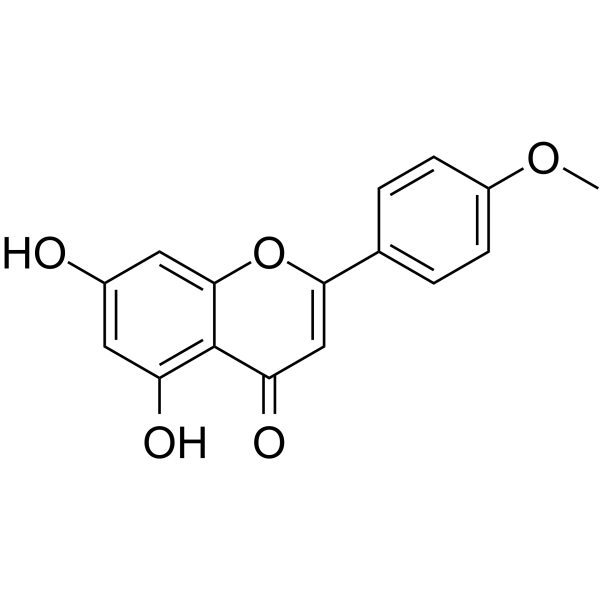天然产物 黄酮类 Flavonoids
Acacetin (Synonyms: 金合欢素; 5,7-Dihydroxy-4′-methoxyflavone) 纯度: 99.84%
Acacetin (5,7-Dihydroxy-4′-methoxyflavone) 是一种口服有效的类黄酮,来自 Tephroseris kirilowii (Turcz.) Holub。Acacetin 停在 PI3Kγ 的 ATP 结合口袋中。Acacetin 导致癌细胞周期停滞,并诱导细胞凋亡和自噬。Acacetin 具有有效的抗癌和抗炎活性,有用于疼痛相关疾病研究的潜力。

Acacetin Chemical Structure
CAS No. : 480-44-4
| 规格 | 价格 | 是否有货 | 数量 |
|---|---|---|---|
| 10 mM * 1 mL in DMSO | ¥660 | In-stock | |
| 5 mg | ¥600 | In-stock | |
| 10 mg | ¥900 | In-stock | |
| 25 mg | ¥1400 | In-stock | |
| 50 mg | 询价 | ||
| 100 mg | 询价 |
* Please select Quantity before adding items.
Acacetin 相关产品
•相关化合物库:
- Natural Product Library Plus
- Bioactive Compound Library Plus
- Apoptosis Compound Library
- Immunology/Inflammation Compound Library
- Natural Product Library
- Anti-Cancer Compound Library
- Autophagy Compound Library
- Medicine Food Homology Compound Library
- Phenols Library
- Orally Active Compound Library
- Traditional Chinese Medicine Monomer Library
- Flavonoids Library
- Food-Sourced Compound Library
| 生物活性 |
Acacetin (5,7-Dihydroxy-4′-methoxyflavone) is an orally active flavonoid derived from Tephroseris kirilowii (Turcz.) Holub. Acacetin docks in the ATP binding pocket of PI3Kγ. Acacetin causes cell cycle arrest and induces apoptosis and autophagy in cancer cells. Acacetin has potent anti-cancer and anti-inflammatory activity and has the potential for pain-related diseases research[1][2]. |
||||||||||||||||||||||||||||||||||||||||
|---|---|---|---|---|---|---|---|---|---|---|---|---|---|---|---|---|---|---|---|---|---|---|---|---|---|---|---|---|---|---|---|---|---|---|---|---|---|---|---|---|---|
| 体外研究 (In Vitro) |
Acacetin (5,7-Dihydroxy-4′-methoxyflavone; 10-200 μM; 24 hours) decreases cell viabilities in a dose-dependent manner. Acacetin has little effect on human normal glial cell line HEB and non-tumorigenic epithelial cell line MCF-10A[1]. Shanghai Jinpan Biotech Co Ltd has not independently confirmed the accuracy of these methods. They are for reference only. Cell Viability Assay[1]
Cell Cycle Analysis[1]
Apoptosis Analysis[1]
Cell Autophagy Assay[1]
Western Blot Analysis[1]
|
||||||||||||||||||||||||||||||||||||||||
| 体内研究 (In Vivo) |
Acacetin (5,7-Dihydroxy-4′-methoxyflavone; 5, 20 mg/kg/day; orally; for 3 days) significantly suppresses microglial activation in an LPS-induced neuroinflammation mouse model[2]. Shanghai Jinpan Biotech Co Ltd has not independently confirmed the accuracy of these methods. They are for reference only.
|
||||||||||||||||||||||||||||||||||||||||
| 分子量 |
284.26 |
||||||||||||||||||||||||||||||||||||||||
| Formula |
C16H12O5 |
||||||||||||||||||||||||||||||||||||||||
| CAS 号 |
480-44-4 |
||||||||||||||||||||||||||||||||||||||||
| 中文名称 |
金合欢素;刺槐黄素 |
||||||||||||||||||||||||||||||||||||||||
| 运输条件 |
Room temperature in continental US; may vary elsewhere. |
||||||||||||||||||||||||||||||||||||||||
| 储存方式 |
|
||||||||||||||||||||||||||||||||||||||||
| 溶解性数据 |
In Vitro:
DMSO : ≥ 37 mg/mL (130.16 mM) * “≥” means soluble, but saturation unknown. 配制储备液
*
请根据产品在不同溶剂中的溶解度选择合适的溶剂配制储备液;一旦配成溶液,请分装保存,避免反复冻融造成的产品失效。 In Vivo:
请根据您的实验动物和给药方式选择适当的溶解方案。以下溶解方案都请先按照 In Vitro 方式配制澄清的储备液,再依次添加助溶剂: ——为保证实验结果的可靠性,澄清的储备液可以根据储存条件,适当保存;体内实验的工作液,建议您现用现配,当天使用; 以下溶剂前显示的百
*以上所有助溶剂都可在 Shanghai Jinpan Biotech Co Ltd 网站选购。
|
||||||||||||||||||||||||||||||||||||||||
| 参考文献 |
|
